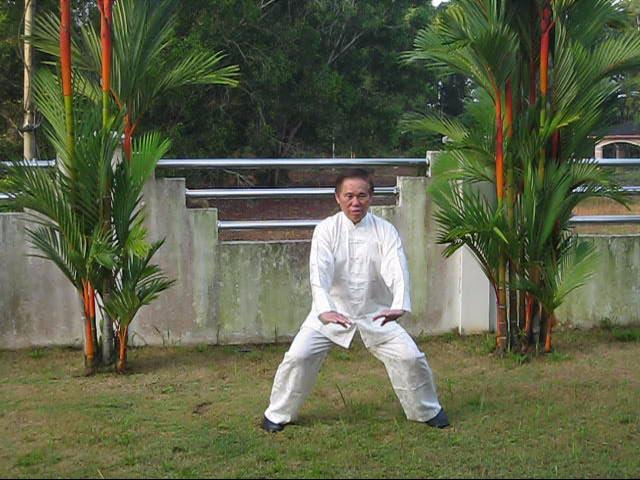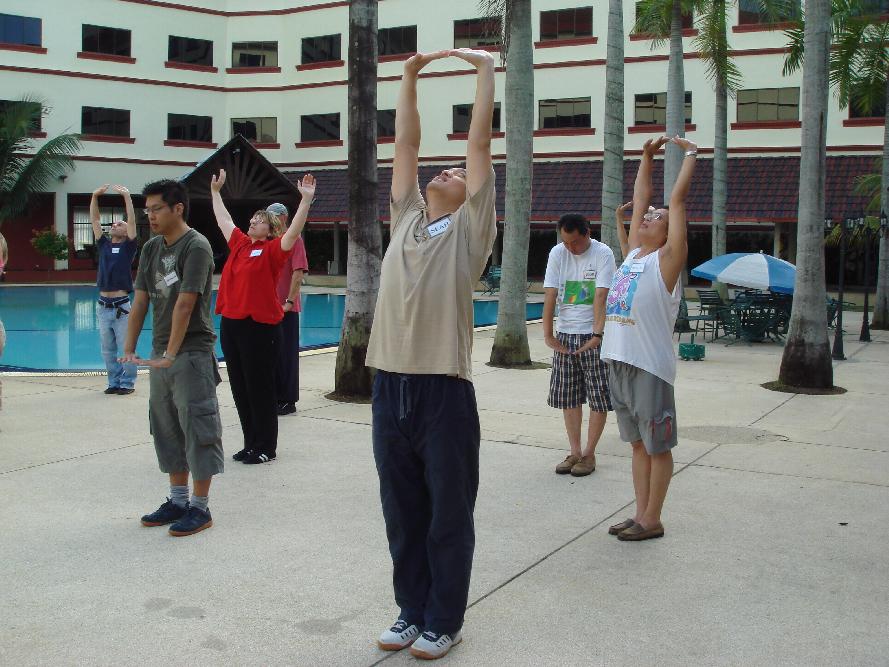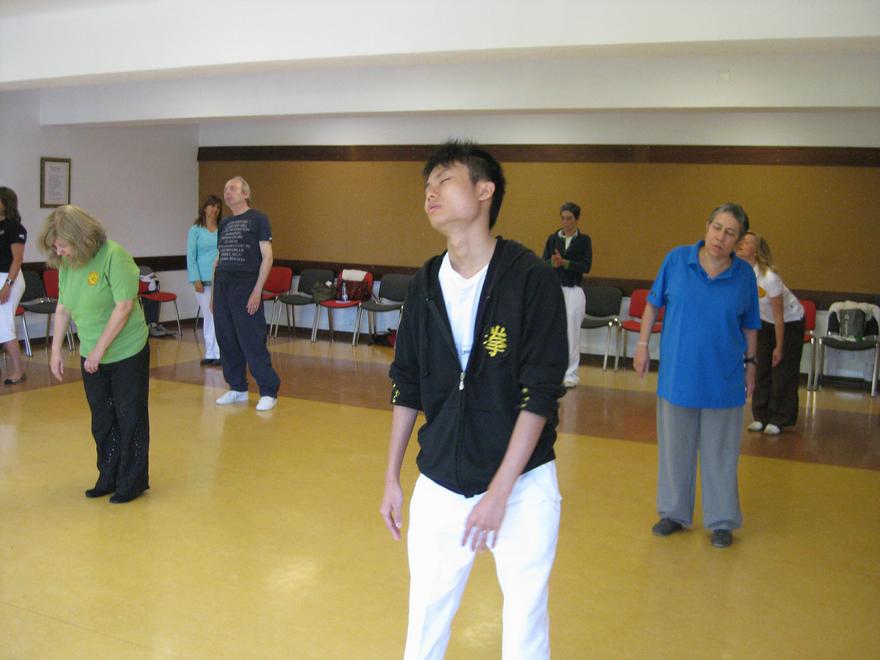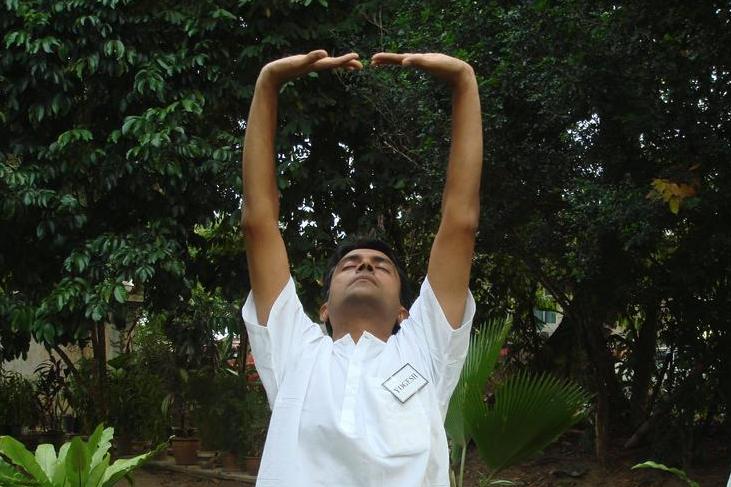SELECTION OF QUESTIONS AND ANSWERS
SEPTEMBER 2012 PART 1

San Zhan is a famous but little known Wuzuquan set that can develop a lot of internal force
Question 1
Sigung, you told us that you first learned Abdominal Breathing when practicing Wuzuquan. Is Abdominal Breathing the same as Cosmic Breathing? Can you tell us your experience in practicing Abdominal Breathing or Cosmic Breathing?
— Dave, Spain
Answer
Abdominal Breathing is not the same as Cosmic Breathing, yet Abdominal Breathing can be Cosmic Breathing. This odd statement will become clear as I describe my interesting experience in learning these two arts.
Though I had heard about it earlier, my first introduction to Abdominal Breathing was through my learning Wuzuquan in the late 1960s in Dungun, a small lovely town by the side of the South China Sea in Trengganu, Malaysia.
Although I already had powerful arms from my earlier Hoong Ka training where I hit a wooden man every night, I found that I was nowhere in force when compared with my Wuzuquan classmates in sparring, and my classmates did not use strength!
This greatly puzzled me. "How could you be so strong when you do not use strength?" I asked my classmates.
"Use internal force," they replied honestly.
"How do you develop internal force?"
"Practice your San Zhan," they kindly advised.
"I do, but I still have no internal force," I protested.
"Perhaps you did not practice correctly."
"I do. Siheng checks my practice every time. And he has a lot of internal force."
"Siheng" here refers to my senior classmate, Sifu Chee Boon Leong, the eldest son of my Wuzuquan teacher, Sifu Chee Kim Thong, and who taught us on behalf of his father.
My classmates thought for a while, then one of them said, "Perhaps you have not learnt Abdominal Breathing yet."
"Aha, Abdominal Breathing! Can you please teach me?"
"Teach you Abdominal Bereathing? You must be joking. Sifu will skin me!"
Abdominal Breathing is an advanced art, taught only to selected senior students after they have proven themselves to be deserving.
But my classmates were very kind to me. After much persuasion and after making me promise that I would not tell Sifu, they eventually taught me Abdominal Breathing. Actually they did not teach me, they showed me the techniques.
I learned the techniques of Abdominal Breathing in less than five minutes. But even after a year, I could not have the skill of Abdominal Breathing, and therefore also not the benefits. I kept reverting back to chest breathing when I tried to practice Abdominal Breathing.
It was years later that I acquired the skills of Abdominal Breathing from my third sifu, Sifu Ho Fatt Nam, as part of his teaching me the Small Universe. This was, of course, done in secret, apart from and unknown to his other students.
At that time, including the time I learned from Sifu Ho Fatt Nam, I did not know the difference between skills and techniques. As a good student I just diligently practiced what my teacher taught me.
It was much later that I differentiated between skills and techniques, which makes us very cost-effective and bring us a lot of benefits. I also improved the techniques of Abdominal Breathing. It is incredible that now Shaolin Wahnam students can develop the skills not just of Abdominal Breathing, but of Cosmic Breathing which is of a higher level, in a four-hour course!
When my sifu, Sifu Ho Fatt Nam, taught me the Small Universe, he taught me, at different stages of my progress, two main modes of breathing, which he called Abdominal Breathing and Reversed Breathing.
I started with Abdominal Breathing, which build a ball of energy at my dan tian. Later when I had to bring my chi up my spine, I used Reserved Breathing. Eventually I used Abdominal Breathing again to complete the Small Universal Flow.
I attained the Small Universe in about two years of daily practice, which was a remarkable achievement, reminding me that I was not called a kungfu genius for no reason. Past masters, I heard, took about ten years.
Small Universe was one of my favourites. I practiced it quite a lot. If you have wondered why I have so much internal force, or so much vitality despite my age, you can guess at the reason here.
I discovered that initially my chi flowed from my nose to my dan tian and then from my dan tian out through my mouth. The chi flow was up and down. Next, the chi flowed round my body in a circuit, the Small Universal Flow. Then the chi flowed in and out of my body at my dan tian. I literally pulsated with the Cosmos. The effects were different, but the technique was the same.
This progression was reflected in the courses I taught, except that our students had the results much faster than I did. At first I taught Abdominal Breathing as an advanced course. The chi flow was up and down the body. Eventually those who kept practicing Abdominal Breathing found that they pulsated with the Cosmos.
So I updated the course and called it Dan Tain Breathing, to differentiate from Abdominal Breathing. Students in Dan Tian Breathing went straight to pulsating with the Cosmos, without first having their chi flow up and down. At first the two terms, Abdominal Breathing and Dan Tian Breathing, were used interchangeably. But gradually a difference was noted between the two terms.
Our courses are constantly being improved, and with the improvement we have to use new terms. Now instead of Dan Tian Breathing we call it Cosmic Breathing, because that is exactly what we do, our energy pulsates with cosmic energy. We keep the original meaning of Abdominal Breathing, whereby energy goes from the nose to the dan tian and from the dan tian out of the mouth
Dan Tian Breathing refers to the technique, whereby the abdominal dan tian rises as energy flows in, and falls when energy flows out. The reverse, whereby the dan tian falls when energy flows in, and rises when energy flows out, is referred to as Reversed Breathing.
Dan Tian Breathing and Reversed Breathing are terms referring to techniques, whereas Abdominal Breathing, Small Universe and Cosmic Breathing are terms referring to skills. We may use the technique of Dan Tain Breathing to operate the skills of Abdominal Breathing, Small Universe or Cosmic Breathing, or we may use the technique of Reverse Breathing to operate the same skills.
Question 2
Of the three categories of illness you have mentioned, contagious diseases, organic disorders and psychiatric problems, which category of illness chi kung is most effective in curing?
Answer
This is an interesting academic question, which means that the answer is for academic interest and may not apply in real life.
Why doesn't the answer apply in real life? It is because in real life many factors are involved which will give rise to different answers.
But this does not mean that an academic answer is not useful. It enables us to better understand the philosophy of chi kung healing.
To have a meaningful comparison as to which category of illness chi kung is most effective in curing, we have to presume that all other factors were equal, and the only difference is the different categories of illness.
Yet, this presents some problems. What aspect of the three categories of illness -- contagious diseases, organic disorders and psychiatric problems -- should we use for comparison? It would not be accurate, for example, comparing curing a contagious disease that is just infected with an organic disorder that has been there for a long time, or a psychiatric problem that is minor with a contagious disease that is life-threatening.
These two aspects of the illness, namely timing and seriousness, are crucial, and we shall therefore use each of them in turn for our comparison.
So, if all other things were equal, right at the start of illness which category of illness is chi kung most effective in curing? It is contagious diseases because the disease causing agents, i.e. the harmful micro-organisms, are not an integral part of the patient's body. Therefore, it is easiest for chi flow to clear them away.
In organic disorders the diseased organ that fails to function normally, and in psychiatric problem the consciousness that is sick, are integral parts of the patient. It requires more time for chi flow to re-transform these diseased parts to enable them to work normally again. Comparatively, it is easier to rectify a psychiatric disorder than an organic disorder using chi flow because the former is more "fluid" than the latter.
Such a situation actually happens all the time. Harmful micro-organisms are attacking people all the time, but even when they do not practice chi kung, their normal chi flow will clear away these disease causing agents, usually without their conscious knowing.
If the illness has gone on for a long time, and if all other things, including the seriousness of the illness, were equal, are contagious diseases still the easiest to be cured by chi kung? No, it is not so, because the situation is now different.
Having been infected by a contagious disease for a long time, a patient's internal structure would have been changed. It will be the most difficult to be rectified by chi flow. Relatively it is easier to rectify an organic malfunction, and easiest to rectify a psychiatric disorder.
It is easier to rectify an organic malfunction than a structural defect caused by a contagious disease because the structural defect is different from the natural healthy structure, whereas the diseased organ. though not functioning normally, still has its natural structure.
But it is easier to rectify a psychiatric disorder than an organic malfunction because the blockage that disrupts the normal functioning of the psyche or consciousness is negative emotional, whereas the blockage that disrupts the normal functioning of the organ is more physical. The emotional blockage is still "nebulous", whereas the physical blockage has been "solidified". It is easier to clear nebulous blockage than solid one.
This situation is also reflected in daily life, though most people may not be aware of it. If a contagious disease has affected a person for a long time, but it is not serious enough to kill him, it also takes the longest time to be overcome compared to a similar minor organic disorder like indigestion or psychiatric problem like being depressed for no apparent reason. Feeling depressed will be the easiest to be overcome.
Now let us consider the aspect of seriousness of the illness in our comparison. If the illness is not serious, and all other things were equal, psychiatric problems are the easiest to be overcome, followed by organic disorders, and then by contagious diseases. It is because the energy blockage that causes the illness in psychiatric problems is "nebulous", whereas that in organic disorders and contagious diseases has been "solidified". In the case of contagious diseases, chi flow not only has to clear the solidified blockage but also to repair the structural damage.
If the illness is serious, the ease or difficulty in overcoming the three categories of illness is also in the same order, and the reasons are also the same. Such examples are not so common in everyday life because patients with serious contagious diseases may not live long enough to provide the comparison. Many people often forget that when the illness is very serious, it is the least life-threatening in psychiatric problems, less in organic disorders, and the most in contagious diseases.
But the comforting point is that we can choose not to allow illness to happen. Chi kung is effective in overcoming illness when it has occurred; it is even more effective in preventing it. And contagious diseases, which are the most deadly of the three categories of illness, are the easiest to be prevented.

An Intensive Chi Kung Course is of a much higher level than a regional chi kung course
Question 3
I introduced the way I had learnt at the Intensive Chi kung Course to teach my students. To my amazement all the student had chi flow the first lesson.
The most interesting and remarkable event happened to a patient of 78 years old. She was hospitalized and had a minor stroke. She was sick and could not eat and walk properly.
After her discharge from hospital, I taught her chi kung while she was sitting. The new method of chi kung exercise taught by Sifu is fantastic. She got chi flow and swaying around even she was sitting. After two days she could eat and walk, and now has already thrown away her wheelchair.
— Dr Foong, Malaysia
Answer
Congratulations for your result regarding the elderly woman who had a stroke. You have saved her.
There is no surprise of your improvement in both your own performance as well as your teaching of chi kung after attending another Intensive Chi Kung Course.
Nevertheless, the following points are very helpful, and their validity has been confirmed from my own experience as well as the experiences of some senior instructors.
Do not teach your students the way you have learnt from me, especially in an intensive course because the nature as well as purpose of an intensive course are different from those of regular classes. Secondly, your attainment level is different from the attainment levels of your students. A good teacher always teaches at the level as well as the needs of the students.
If you teach the way I teach in an intensive course, your teaching of course will be of a higher level, but it is not to the best interests for your students as well as for you. It is too powerful for your students. As they attend your regular classes, they have more time which allows you to spread your teaching over a period of time instead of concentrating it in a single day as in an intensive course.
Moreover, as students already have intense result at first, they may become bored later on when the result is not as intense, and this will affect their chi kung progress. It is like teaching primary school lessons to kindergarten pupils. The small pupils may be smart at first, but they become dull in later school life.
However, teaching high-level chi kung in emergency, like to the elderly woman who had stroke, is correct. This is to save life or a serious condition so that you have more time later to carry out remedial work.
Question 4
Do we accept people who are over 80 and people whom we suspect may be gay, lesbian or transvestite?
Answer
While it is true that people over 80 are slower in learning and recovery, we still accept them. We will do our best to enable them to have a joyful, healthy life in old age.
We decline teaching or treating those, irrespective of their age, who are undeserving, who can benefit more from other teachers or healers, or whom we feel may not benefit from our teaching or healing.
While we do not encourage gay, lesbian or transvestite activities, we sympathize with people having these tendencies. We accept them as students and help them to regain respect and confidence, and to lead a meaningful life.

Students at a regional course in Portugal enjoying chi flow
Question 5
I have read that it is essential that Chi Kung is practiced daily to receive full benefit, but I have also read elsewhere that you should not practice Chi Kung 24 hours before or after sex as it is harmful to the body,
— Harry, UK
Answer
There are many different types of chi kung of different levels catering for different needs. Therefore, statements that are applicable to some types of chi kung may not be applicable to others. Even for the same type of chi kung, certain statements may apply to some practitioners but not to others.
While it is highly recommended to practice chi kung every day, it is not essential. In other words, if you miss a day or two of practice, you can still get a lot of benefits. In some situations, like when a practitioner is weak or the type of chi kung is powerful, he may get more benefits by practicing on alternate days than on every day.
Not practicing chi kung 24 hours before and after sex is recommended only on special situations, like when a practitioner is practicing a demanding type of chi kung like Iron Shirt. After sex the practitioner is weakened, and may not be able to withstand strikes made on his body in Iron Shirt training. On the other hand, having endured the training he may not have sufficient energy left to perform sex.
You would be pleased to know that both abstinence of sex after chi kung, and abstinence of chi kung after sex, do not apply in normal situations. In other words, if you are a normal person doing normal things, there is no harm if you enjoy practicing chi kung then have sex, or enjoy sex then practice chi kung.
Question 6
If I want to practice Chi Kung properly do I have to abstain from sex because even regular practice of Chi Kung would be difficult if I were to have sex only twice a week?
Answer
No, you don't have to abstain from sex if you want to practice chi kung properly. Regular practice of chi kung would be easy if you are to have sex only twice a week.
In fact, except for special situations like the one mentioned above, irrespective of whether a person has sex every day, or only on some days, or not at all, he can practice chi kung everyday. There is also no harm if he misses his chi kung practice on some days.
The good news is that if you wish to have sex more than twice a week, which is a pleasurable thing to do provided you have the required energy to do the job, and of course also a willing partner to share your joy, practicing high-level chi kung everyday will help you fulfill this aspiration.

Lifting the Sky
Question 7
Nurses threaten me, and I become afraid. Please help me, and maybe you can talk with the nurses so they will pamper me.
— Michel, Netherlands
Answer
You may have done something bad that the nurses threaten you. Do something good to them and they will adore you.
Getting the nurses to pamper you is not an enviable thing to do. It would be better if you pamper the nurses.
Question 8
Psychiatrists declared me schizophrenia of the paranoid type. I've practised "Lifting the Sky" and "Golden Bridge" for years. What is the best exercise to cure my sickness? I own "The Art of Chi Kung" and "Chi Kung for Health and Vitality".
Answer
Schizophrenia can be overcome. An excellent way to overcome schizophrenia is to practice high-level chi kung.
But learning chi kung exercises from books is not likely to get you practice high-level chi kung. Worse, you may practice the exercises wrongly, which can give you adverse effects.
It is not the type of exercises but how you practice them that is important. "Lifting the Sky" and "Golden Bridge" can bring high-level results if you learn them from a competent teacher and practice them correctly. But if you learn the same exercises from books, even when you practice them correctly, it is unlikely you will have high-level results.
Why is it that when you practice the same exercises correctly, you will get low-level result if you learn them from books, but high-level results if you learn them from a competent teacher? It is because a competent teacher can teach you skills and supervise your training so that you your results are high-level, whereas books may not.
I would recommend you to attend my Intensive Chi Kung Course. It is advisable if you come with a family member or a friend who can look after you. It is best if your family member or friend attends the course too, but if he or she just accompanies you to give support, that is fine too.
LINKS
Selected Reading
- San Zhan
- Zen and Tao
- Would You Believe tha One Could Learn Kungfu Sparring in Just Three Days?
- Chi Flow and Cash Flow
- Quiscent Methods and Dynamic Methods of Force Training
